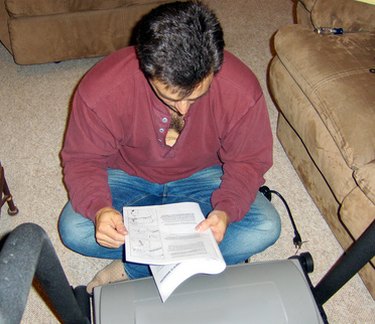
Avoid time consuming and costly mistakes by planning your pellet stove installation ahead of time. Check for framing members within the walls and ceilings where you plan to cut holes, and if there are some in the way you should adjust the stove's location. Follow manufacturer's installation requirements specific to your pellet stove. Lay out a plan on paper, verify all dimensions and have your stove dealer review the plans.
Placement
Video of the Day
Put the stove where nothing combustible can get too close. Keeping items at least 3 feet away provides a margin of safety. If the ceiling height is less than 7 feet, the space where the stove is installed must be large enough to accommodate the volume of heat the stove will produce, and still provide adequate combustion air. In most cases, mobile home installations require combustion air drawn from the outside. This can be pulled from below the home if the space is vented, or through the wall. The floor must be level, secure and capable of holding the stove's weight. Also calculate placement by considering the type of vent to be used and by following the vent manufacturer's clearance requirements. Place the stove near a standard power outlet.
Video of the Day
Floor Protection
Use a noncombustible floor protector underneath the stove. The floor protector must be at least the same width and depth of the stove. It must extend at least 6 inches beyond the front of the stove.
Clearances
Pellet stoves require certain clearances from nearby materials so they do not overheat the materials and cause them to catch on fire. Each model and each manufacturer has potentially different requirements, and it is the responsibility of the installer to follow those requirements. Manufacturers of pellet stove vents also have their own requirements for clearances of the vents. When using a tee for a vertical vent, install the tee and then add the vent manufacturer's clearance requirements to arrive at the stove's placement.
Electrical
The stove requires a standard 115 volt grounded outlet located where it is not necessary to route the power cord over, under or in front of the stove.
Venting
Do not connect the vent to a vent being used by any other appliance. Do not install a flue damper, and use a ceiling support or fire stop spacer where a vent pipe passes through a ceiling. Manufacturers may limit the amount and type of elbows that should be used. For example, the Lopi Leyden stove cannot have vent pipes that exceed a total of 180 degrees of elbows. That would be two 90 degree elbows, or one 90 degree elbow and two 45 degree elbows. Support for the pipe when it is outside the building is necessary so it does not buckle from its own weight or because of wind. Manufacturers specify maximum vent heights, and the stove will not operate at all or will not operate effectively if you exceed those. Pipe diameters generally range from 4 to 6 inches. Use a cap on the vent pipe to prevent water, birds and rodents from entering.